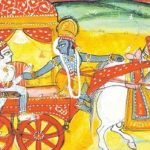THE PLAY OF THE GUNAS
BY SWAMI DURGANANDA
At the occasion of Swami Durgananda’s 70th birthday celebrations, the booklet Inner Path was released offering a selection of Swamiji’s lecture extracts on yoga as a practical system of universal spirituality.
We share below teachings on the practical applications of the concept of the gunas in daily life, as contained in this special anniversary booklet.
 The Sanskrit term guna is usually translated as ’quality.‘ The three gunas – sattva, rajas, and tamas – represent the characteristic parts and the substance at the basis of nature, prakriti.
The Sanskrit term guna is usually translated as ’quality.‘ The three gunas – sattva, rajas, and tamas – represent the characteristic parts and the substance at the basis of nature, prakriti.
In order to attain liberation, we must transcend them as they are forms of avidya, ignorance. The gunas are the basis for identification with body and mind. The person who has left behind the three gunas is free from birth and death, decay and pain, and will attain Self-knowledge.
The gunas manifest as:
Sattva (purity, cleanliness, crystal, white). If a person is dominated by sattva, he or she exudes the light of wisdom and the power of discrimination. Pure and elevating thoughts and pure understanding are dominant in the mind of the person who turns away from sensual pleasures and toward knowledge.
However, it is possible to identify so strongly with sattva that attachment develops. At this point the sattvic person enjoys her or his own superiority and boasts about it.
Most importantly for our spiritual development is to cultivate sattva in the overall thought pattern. Take for example driving a car: calmly and full of energy, fast but with control — that is what we mean by sattvic.
Sattva when taking food means to eat unhurriedly and with pleasure, enjoying the taste, and not to wolf down the food thoughtlessly. Sattvic means to continue a conversation calmly during a heated discussion; sattvic is the reaction of a surgeon who suddenly faces an unforeseen complication during an operation and reacts with control. The principle applies to all ways of life. It also means to keep a sense of perspective and to remain calm, to approach something thoughtfully and to concern oneself with it until the matter is completed; it is this method which distinguishes a successful person.
Rajas (restlessness, desire, greediness, red). Rajasic activity can be confused with Karma Yoga or godly activities. Seemingly, selfless service for the world becomes rajasic when the motive behind the activity is linked to personal desires. There are people who cannot sit still even for a minute, and have to keep themselves busy in one way or the other.
A yogi or wise person who sits still, is physically immobile, and tames his mind is the most active person in the world.
When intensive activity happens on the basis of sattva, it gives the impression of a wheel that is turning very fast yet appears to be standing still. In contrast to this is uncontrolled energy, which appears so smooth and active. Rajasic describes people who never have time, and who never really feel the need to reflect because they are always in a hurry.
Tamas (forgetting one’s duty, confusion, darkness, lack of discrimination, extreme lethargy, mindlessness, losing one’s head, errors, black). When nature is in darkness, at night, it is time to rest the body and sleep. If the natural rhythm of sleep and wakefulness is neglected too much, tamas is increased. The science of Ayurveda calls it kapha.
If tamas, lethargy, dominates the physical body, the condition transfers to the mind, to the intellectual and emotional sheath, and depression can follow as well as shortness of breath, aggressive behaviour, and a feeling of being overtaxed by the daily routine.
Calmness which is obtained through the use of mood-changing medication, alcohol, or drugs is tamasic.
Tamas frequently manifests itself quite subtly:
You are happy and un-happy in succession. Sometimes you sleep too much and then not enough; sometimes you are contented and patient, at other times you are discontented and impatient; sometimes full of love, other times full of hatred.
Swami Vishnudevananda’s five points of yoga – proper exercise, proper breathing, proper relaxation, proper diet, positive thinking and meditation – are a well-proven method to rid the system of accumulated tamas.
The gunas are to prakriti what single jewels are to gold. Just as you cannot separate heat from fire, so the gunas and prakriti cannot be separated and are identical.
The sun is reflected on water. The water moves and has waves and so it appears that the sun moves or has waves on its surface. In the same way, atman appears to be moving when the gunas traverse the mind. But atman is always untouched. The phenomenon is a superimposition.
In the manifested world the gunas are in a state of unbalance and are evident in all aspects of life: nutrition, action, faith, etc. Their effect on the mental plane has to be recognized so that they can finally be overcome.
Gunas and Action
We see the workings of the gunas when we act. Every day we encounter one ‘problem’ or another, the difference lies in how we respond to it.
We can reflect on our response in our contemplation or meditation in the evening: “Was my reaction to another person in an unpleasant situation sattvic? Did I give the other person space and see that the problem will eventually be solved? Did I react in a rajasic way with equal intensity? Or did I turn away in a tamasic and lethargic way?”
The situations which cause difficulties are always of the same kind, but depending on external circumstances, they always appear unique. One‘s reaction to them, and one’s own behaviour, are the result of samskaras, the subtle impressions from many previous lives, but also from the present incarnation.
These impressions have created desires in the past and they continue to do so.
The desires then carry the mark of the predominant guna and can show up at any moment.
It is therefore obvious that as long as all three gunas have not been transcended, then samsara, the wheel of birth and death, keeps revolving.
Generally, when we speak of activity in yoga, we mean rajo guna, but in any one activity all three gunas can manifest. Swami Sivananda says in chapter 14 of his commentary on the Bhagavad Gita, the chapter about the gunas, that restlessness can lead to an action which we regret afterward.
The action is completed to fulfil one’s own desire rather than to do that which needs to be done. The motive behind an action is always what makes the difference.
lt is extremely important to reflect on it and analyse whether this motive is sattvic, rajasic, or tamasic. We may think we are acting selflessly but are in fact fulfilling our own need for fame and recognition. Sattvic peace does come from action, but only from action which is free of egoism.
Otherwise restlessness is created and you become a workaholic, then you become exhausted, then burn out, then turn into a couch potato who is no longer able to do anything, at which point this tendency changes back into restlessness and the wheel starts turning again. lt is like the movement the world of work becomes a slothful, lazy person who almost vegetates in a swamp on the weekend. Real cleanliness, true sattva, presupposes that this difference does not exist.
The coexistence of rajas and sattva, however, is the result of intensive training which makes it possible to think in sattva and be active
at the same time; a wonderful picture of personal evolution can be realized.
Sattvic activity is the result of calm and concentrated reflection on what needs to be done, which steps need to be taken, in order to serve oneself and humanity. Seen from the outside, it does not appear as action, but as a matter of fact that is the very best activity we can have. Pausing for a moment, and practicing some self-observation before and after the activity calms the mind and the activity becomes sattvic.
Gunas and Avidya
The gunas are considered avidya, a superimposition over vidya. That is why the knowledge of the gunas and their functions is essential in order to free oneself from
the clutches of ignorance. With proper detachment we have to keep our distance from the superimposition of the gunas over the atman.
No one can escape the effects of the gunas, but it is important to analyse this phenomenon. It is important to understand its characteristics, to take on the role of
observer rather then identifying with the gunas, to become a gunatita, i.e. one who detaches from the gunas. This is not possible without understanding how they function.
The fifth verse of the 14th chapter of the Bhagavad Gita says: “Purity, passion and inertia – these qualities, O Arjuna, born of Nature, bind fast in the body, the embodied, the indestructible.” Whoever identifies with these qualities of nature binds himself to the various sheaths, upadhis, and therefore cannot see the indestructible, the soul, within.
We identify with genetic tendencies, which are an expression of prarabdha karma. Yoga teaches us to give up the identification with the instruments, the body and the mind.
Charateristic tendencies are an expression of the gunas, and yoga teaches us to see them, to analyse them, not to identify with them, and to finally overcome them and develop the true Self.
Gunas and Faith
If tamas is predominant, faith will be extinguished, says the Bhagavad Gita. The mind is too lethargic to argue, everything is seen from a negative perspective, the person does not believe in anything.
Everything new will be dismissed first of all as bad, negative and useless; the mind is too lethargic to consider it in any depth or to form an opinion. The belief in oneself and in one’s own capacities is weak.
One does not consider the possibility that one could get a certain job, and there for one does not even try or apply. That is a clear sign of tamas domination.
In the rajasic state, according to the Bhagava Gita, the person strives for liberation. There is a prevailing belief in the good and, even, in errors, the good, positive, and instructive is seen.

This is the reason why great and successful people feel sympathy for the errors of others, a feeling which stems from an inner sattvic state. They know the shortcomings which are common to all. People who act in sattva become stronger and more knowledgeable.
Gunas at the Moment of Death
In chapter 14, the Bhagavad Gita deals with the gunas at the moment of passing, when death of the physical body takes place. It explains that the predominant guna at the moment of passing decides the situation of the next incarnation. This is why all cultural rituals accompanying death are designed to calm the mind and lead it to sattva.
If you have the wonderful opportunity to accompany someone at this moment, you can be of assistance, depending on the religion or culture to which the dying person belongs. The frequent tendency to push death aside, not to deal with it, is rajasic.
Death is a crossing-over. Yoga knows that it is only a question of matter returning to the elements. The soul, enshrined in the subtle body, does not cease to exist.
Swami Durgananda is Yoga Acharya (spiritual director) of the Sivananda Yoga Centres in Europe































